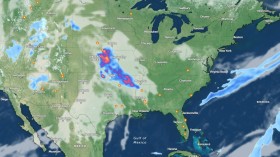Around 400 million years ago, the emergence of the first terrestrial plants with penetrating roots may have precipitated a series of oceanic mass extinctions.

The emergence of Large Rooty Plants
The emergence of plants on solid ground was a significant event that fundamentally altered the terrestrial ecosystem. The effects on our seas may have been just as severe, say researchers from the University of Southampton in the UK and Indiana University-Purdue University Indianapolis (IUPUI) in the US.
The marine environment had several mass extinction events throughout the Devonian Period, which lasted from 360 million to 420 million years ago. Near the conclusion of this time, a particularly severe event led to the loss of up to roughly 60% of all oceanic taxa.
According to some experts, the main reason for these losses was trees.
Also Read: Scientists Presents Timeline for the Possibility of Earth's Sixth Mass Extinction
Plant Evolution

Plants grew farther and farther from water sources as they searched for new nutrition sources. Their roots would have eventually started to extract phosphorous from subterranean rocks.
As the tree decomposes, the nutrients in its biomass more readily dissolve into the groundwater, eventually finding their way to the ocean.
When root systems developed and migrated more inland throughout the Devonian, increasing amounts of phosphorus would have been released into the sea environment.
These nutrition pulses have a new timetable that points to their demise. The information is based on the chemical examination of rocks found in Greenland and Scotland's and Greenland's old lake beds and beaches.
IUPUI earth scientist Gabriel Filippelli says, "Our work demonstrates that the emergence of tree roots probably swamped previous oceans with extra nutrients, creating a huge algal bloom."
These quick and devastating algal blooms would have lost most of the oceans' oxygen, resulting in catastrophic mass extinction events.
Although researchers have previously hypothesized that tree roots contributed to Devonian mass extinctions, this work is one of the first to estimate the quantity and time of phosphorus delivered from land to water.
The amount of phosphorus in the lake environment varied from site to site, but overall, most examples point to significant and quick shifts over the Devonian.
The fact that significant extinction events during this time period and growing phosphorus levels in the ocean mainly coincide shows that the enhanced nutrient contributed to the problem.
At each site under study, phosphorus export peaks sometimes occurred at different times or with the same magnitude, but the scientists believe this is to be anticipated. They add that rather than being a "one punctuated event," the colonization of land by plants "likely staggered regionally, culminating at different periods in different sections of Euramerica and other portions of the Devonian Earth."
Depending on the region, different rates of phosphorus depletion caused marine extinction events that lasted for millions of years. Although the specific mechanisms governing nutrient uptake, plant development, and decay probably varied, a general pattern appears to have emerged. Researchers discovered that the transport of phosphorus to lakes increased during drier periods. This finding raises the possibility that tree roots may rot and release nutrients in the absence of sufficient water.
Trees aren't nearly as harmful to marine life compared to when they originally appeared. Since soil on land is now considerably deeper, phosphorus-containing organic molecules can more readily cycle through the environment since mineral-bound phosphorus may hide well beyond the reach of roots.
However, worrying patterns between what is occurring now and what happened hundreds of millions of years ago may be found.
Although atmospheric levels of carbon dioxide and oxygen peaked during the Devonian, they did so more slowly than they have recently because plant life had not yet advanced as quickly as it has in recent times.
Roots Contamination
No tree roots are necessary for the pollution from fertilizers and organic waste to reach the ocean. We pump it there, causing "dead zones" of low oxygen in numerous significant marine and lake environments.
According to Fillipelli, "These new insights into the devastating effects of natural catastrophes in antiquity may serve as a warning about the effects of comparable circumstances coming from human activities today."
Related Article: One of the World Largest Mass Extinctions May Have Been Triggered by Volcanic Winter
For similar news, don't forget to follow Nature World News!
© 2024 NatureWorldNews.com All rights reserved. Do not reproduce without permission.


![Roundworms with Short Memories 'Stop Forgetting' When Frozen or Given Lithium [Study]](https://1471793142.rsc.cdn77.org/data/thumbs/full/70295/280/157/50/40/roundworms-with-short-memories-stop-forgetting-when-frozen-or-given-lithium-study.jpg)


